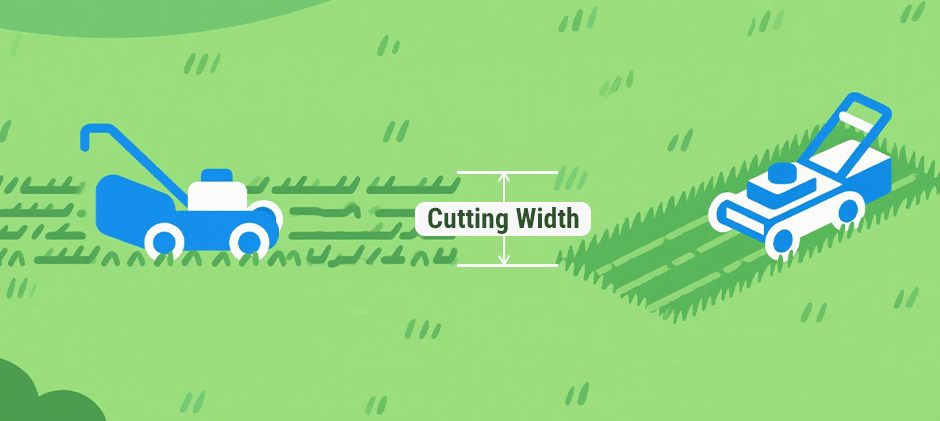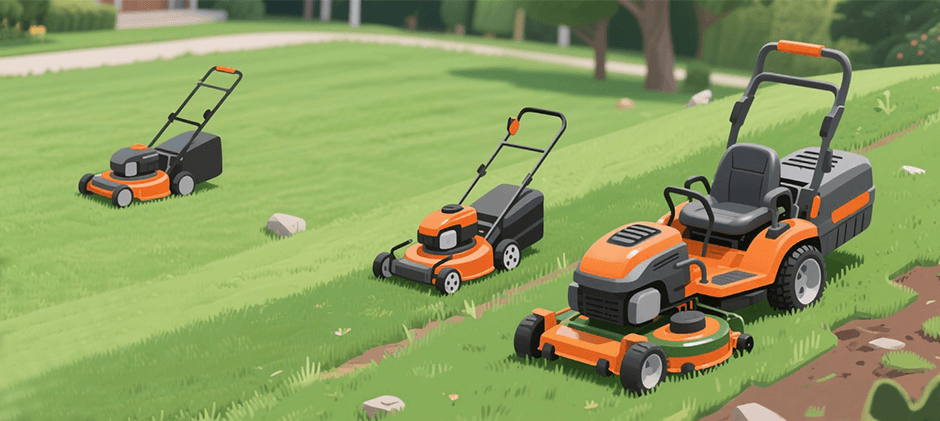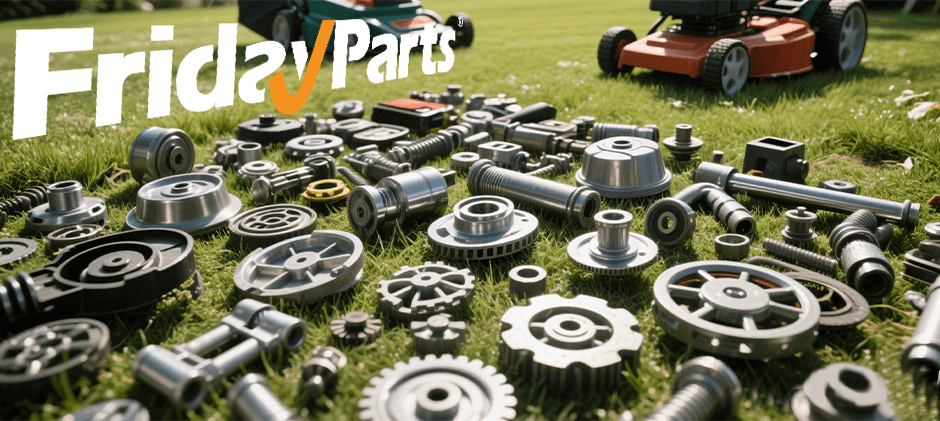The lawn size is a critical consideration for lawn mower size. Choosing the right lawn mower is not a casual decision; it can be a determinant of your mowing efficiency, and even influence the long-term availability and cost of essential mower parts to keep it running smoothly. The sheer variety of types, sizes, and features can be overwhelming. However, one of the most critical factors to get right is the mower size, specifically its cutting width or deck size. Selecting an appropriate mower size ensures you can mow your lawn efficiently, achieve a quality cut, and avoid unnecessary frustration. This guide will help you determine the best mower for your yard by considering key factors like yard size, terrain type, and maneuverability.
Related post: How to Change the Oil Filter in a Lawn Mower?
Why Mower Size Matters?
Picking a mower that’s too small for your property size means you’ll spend excessive time mowing. You’ll make more passes, use more fuel (if applicable), and potentially experience premature wear on the machine. Conversely, a mower that’s oversized for a small yard can be difficult to maneuver around obstacles, may not fit through gates, and could be an unnecessary expense. The ideal mower size strikes a balance between mowing efficiency and practicality for your specific lawn.

Key Factors to Determine Mower Size
Several elements come into play when selecting the right mower. Let’s break them down:
1. Yard Size (Acreage)
This is often the primary determinant for mower deck size. The larger your yard, the wider the cutting deck you’ll generally want to reduce mowing time.
Small Yards (Up to 1/4 Acre):
-
- For these compact spaces, push mowers (manual reel, electric, or gas-powered) are often sufficient.
- Cutting widths typically range from 14 to 22 inches.
- A walk-behind mower, possibly self-propelled for slight slopes or ease, is a popular choice.
- What size lawn mower do I need for 1/4 acre? A 20-22 inch walk-behind mower is usually a good fit.
Medium Yards (1/4 Acre to 1/2 Acre):
-
- You might consider larger walk-behind mowers (21-30 inches) or entry-level riding mowers.
- Self-propelled mowers become more beneficial here to reduce fatigue.
- If opting for a riding mower, a lawn tractor with a deck size of 30-42 inches can be suitable.
- What size lawn mower for a 1/2 acre? A 22-30 inch self-propelled walk-behind or a riding mower with a 30-42 inch deck.
Large Yards (1/2 Acre to 2 Acres):
-
- Riding lawn mowers, including lawn tractors and zero-turn mowers (ZTRs), are highly recommended.
- Look for deck sizes ranging from 42 to 54 inches.
- What size zero-turn mower for 1 acre? A ZTR with a 42-48 inch deck offers a good balance of speed and maneuverability.
- What size riding mower for 2 acres? Consider a 48-54 inch deck on a lawn tractor or ZTR for efficiency.
Extra-Large Yards (2 Acres and More):
-
- Larger riding mowers, garden tractors, or commercial-grade zero-turn mowers are the most efficient choices.
- Deck sizes of 54 inches and above will significantly reduce mowing time.
- Best mower for 3 acres? A ZTR or garden tractor with a deck of 54 inches or wider is ideal.
Here’s a quick lawn mower sizing chart as a general guideline:
| Yard Size | Recommended Mower Type | Suggested Deck Width (Cutting Width) |
|---|---|---|
| Up to 1/4 Acre | Push or Self-Propelled Walk-Behind | 14 – 22 inches |
| 1/4 to 1/2 Acre | Self-Propelled Walk-Behind or Small Riding Mower | 21 – 30 inches (Walk-Behind) / 30 – 42 inches (Riding) |
| 1/2 to 1 Acre | Riding Mower (Lawn Tractor or ZTR) | 42 – 48 inches |
| 1 to 2 Acres | Riding Mower (Lawn Tractor or ZTR) | 46 – 54 inches |
| 2+ Acres | Garden Tractor or Large ZTR | 54 inches and up |

2. Terrain Type and Obstacles
The landscape of your yard plays a crucial role in mower selection.
Flat Terrain: Most mower types can handle flat lawns. The main consideration here is mowing efficiency based on size.
Uneven Terrain or Hilly Yard:
-
- For slight slopes, a self-propelled walk-behind mower offers better control and less physical exertion than a push mower.
- For steeper or more hilly yards, a riding mower with good traction and stability is essential. Rear-wheel drive or all-wheel drive models can be beneficial.
- Zero-turn mowers can be very effective on moderate slopes, but some models may struggle with traction on very steep or wet hills. Always check manufacturer recommendations for slope handling.
- Consider mowers with larger rear wheels for better stability on uneven ground.
Obstacles (Trees, Flowerbeds, Landscaping):
-
- If your yard has many obstacles, maneuverability becomes key.
- Zero-turn mowers excel at navigating tight turns and mowing closely around objects.
- Smaller deck walk-behind mowers are also more maneuverable than larger riding mowers in complex landscapes.
- A very wide deck might be efficient in open areas but cumbersome in tight spaces.
3. Gate Width
This is a simple but often overlooked factor. Before you select a riding mower or a wide walk-behind mower, measure the width of any gates or narrow passages the mower needs to fit through. Ensure the mower’s total width (not just the deck size, but including the discharge chute if it doesn’t fold up) is less than your narrowest access point.
4. Mower Types and Deck Sizes
Let’s briefly touch upon common mower types and how their typical deck sizes relate:
- Push Reel Mowers: Generally 14-20 inches. Best for very small, flat lawns.
- Electric/Cordless Walk-Behind Mowers: Typically 14-22 inches. Good for small to medium, relatively flat lawns.
- Gas-Powered Walk-Behind Mowers (Push & Self-Propelled):
- Push mower deck sizes by yard size: 20-22 inches are common for small to medium yards.
- Self-propelled mowers: Often 21-30 inches, suitable for medium yards or those with slopes.
- Riding Lawn Mowers (Lawn Tractors): Usually start around 30 inches, with common sizes being 38, 42, 46, and 54 inches. Best for 1/2 acre and up.
- Zero-Turn Mowers (ZTRs): Available in a wide range, from residential models around 34-42 inches up to commercial units exceeding 72 inches. Known for speed and maneuverability, making them great for 1/2 acre and up, especially with obstacles.
- Garden Tractors: These are more powerful versions of lawn tractors, often with larger decks (48-60+ inches) and the ability to use ground-engaging attachments. Suitable for very large properties (2+ acres).
5. Mowing Time & Efficiency
A wider cutting width directly translates to fewer passes needed to cover your lawn, thus reducing mowing time. If minimizing time spent mowing is a high priority, and your yard can accommodate it, opt for the largest appropriate deck size. However, remember that a very large deck on a residential mower might be overkill for a smaller yard and can reduce maneuverability.
6. Personal Preference & Physical Ability
Consider your comfort and physical capacity.
- If pushing a mower is strenuous, a self-propelled mower is a wise investment.
- For larger areas, a riding mower significantly reduces physical effort and can make lawn care more enjoyable.
- Features like comfortable seating, easy-to-reach controls, and good visibility can also influence your decision.

Conclusion
Choosing the appropriate mower size for your yard involves a careful assessment of your property size, terrain type, obstacles, and personal preferences. By considering the cutting width in relation to your acreage, understanding how different mower types handle various conditions, and not forgetting practicalities like gate width, you can select a machine that makes lawn maintenance efficient and effective. An underpowered or undersized mower will lead to frustration, while an oversized one can be cumbersome and an unnecessary expense. Take the time to measure your yard and evaluate its characteristics to find the best mower for your yard.
Once you’ve selected the ideal mower for your yard, keeping it in top condition is key for long-lasting performance. At Fridayparts, we understand the importance of reliable equipment. We offer a vast inventory of high-quality aftermarket parts for lawnmowers at affordable prices. Whether you need a new blade, a filter, or an engine component, our wide compatibility ensures you can find what you need to maintain your mower and reduce downtime. Explore Fridayparts to keep your mower running efficiently season after season!
